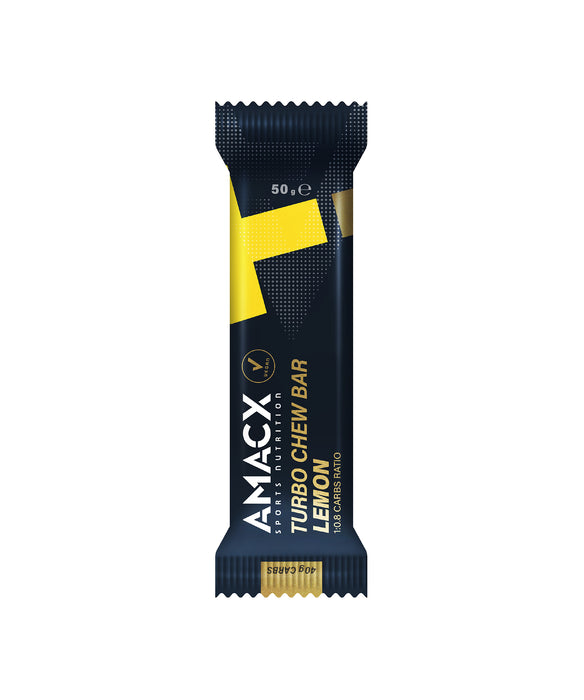
Amacx Turbo Chew Bar Lemon 12 pack
Shipping costs for orders under €50

Anyone who rides a road bike knows: Without energy, there's no speed. And anyone who rides for more than 90 minutes quickly realizes how crucial proper fueling is — that is, targeted energy intake before, during, and after the ride. But what does "proper" mean? What's best to eat before a race or a long ride? Which gels, bars, or drinks make sense while on the road? And what does optimal recovery look like?
Von Vincent Augustin |
3 minutes read time

Your body stores carbohydrates in the form of glycogen – primarily in the muscles and liver. But these stores are limited. During intense workouts or long rides (e.g., > 2 hours), they are often insufficient. Without a regular energy supply along the way, your performance drops noticeably. The famous "hunger spike" is then not far away – a drop in performance that feels like someone is pulling the plug.
Efficient fueling ensures that you…
…can deliver consistent performance,
…maintain mental clarity,
…use and fill your storage better,
…regenerate faster.
Goal: Well-filled glycogen stores and stable digestion.
When?
Ideally 2-3 hours before the start.
What?
A high-carbohydrate, low-fat, low-fiber meal. Easily digestible, familiar, not too experimental.
Example breakfast before a long tour:
Oat flakes with banana and honey
White bread with jam
A glass of apple juice spritzer or a decaffeinated coffee
Tip:
If you have little time in the morning (e.g. if you have an early start), a small snack 30-60 minutes before departure helps: half a banana, an energy bar or a rice cake with some honey.
Goal: Conserve glycogen stores and continuously replenish energy.
When?
By the 60th minute at the latest—better before. Don't wait until you get hungry!
How much?
Depending on intensity and body weight, you should consume approximately 40–90 g of carbohydrates per hour. Trained athletes can consume as much as 100 g or more per hour with exercise.
What?
A mixture of glucose and fructose is ideal, as this allows more carbohydrates to be absorbed per hour.
Examples for 60 g carbohydrates:
1 energy gel (~25 g) + 1 banana (~25 g) + 500 ml isotonic drink (~10 g)
2 bars of 30 g carbohydrates each
3 rice cakes + sports drink
Natural alternatives:
Dried dates or figs
Salty rice balls or small wraps
Bananas or fruit purees
Don’t forget liquid:
Especially in summer, you should plan on drinking 500–1000 ml of water or electrolyte drink per hour – depending on temperature, sweating rate and exertion.
Goal: Replenish glycogen stores, supply muscles, promote recovery.
Timing:
Within 30 minutes of exercise – use the “Open Window”!
What?
A combination of carbohydrates and protein is ideal in a ratio of 3:1 to 4:1.
Examples of recovery snacks:
Protein shake with banana and oatmeal
chocolate milk
Wrap with chicken and couscous
Tip:
Salty foods such as nuts or broth also help to balance the electrolyte balance – especially after hot days.
In competition, it's not just fitness that counts – your stomach is too. Therefore, focus on fueling during training so you know what you can tolerate. Many recreational riders forget: the stomach is a muscle that can be trained. Eating and drinking regularly while riding can improve its absorption.
Pro tip: Calculate your needs in advance and prepare your nutrition before the race. The less you make spontaneous decisions, the more stable your race will be.
Not drinking enough.
Even a 2% loss of fluid can noticeably reduce your performance.
Wait until you're hungry.
If you eat too late, you eat too little – or too much at once.
Try something unusual.
A new gel or a hard-to-digest breakfast before an event? Not a good idea.
No focus on regeneration.
Especially on multi-day tours or intensive training blocks, recovery is crucial for your performance the next day.
Those who eat and drink strategically ride longer, faster, and recover better. Whether you're an ambitious recreational cyclist or a racing driver, smart fueling isn't a luxury, but a prerequisite for progress.
Plan your nutrition like you plan your training: systematically, with experimentation during training—and with genuine enjoyment. Because the best fueling only works if you enjoy it.

Gravelbikes sind in den letzten Jahren zu echten Allroundern auf dem Fahrradmarkt geworden. Sie kombinieren die Sportlichkeit eines Rennrads mit der Robustheit eines Mountainbikes und sind ideal für alle, die sowohl auf Asphalt als auch auf Schotterwegen unterwegs sein wollen. Doch gerade Einsteiger stellen sich oft die Frage: Bekommt man ein gutes, modernes Gravelbike schon für unter 1000 Euro? Die Antwort lautet: Ja – wenn man weiß, worauf es ankommt.

Wer viel Rennrad fährt, kennt das Gefühl: Anfangs ist alles wunderbar – der Wind pfeift, die Beine laufen, die Strecke ist dein Element. Doch nach einer Stunde meldet sich dein Hintern. Erst leicht, dann stechend, schließlich so brennend, dass jeder Tritt zur Qual wird. Willkommen im Club: Satteldruck und gereizte Haut gehören zu den häufigsten Beschwerden unter Radfahrer*innen – und kaum jemand spricht offen darüber.
Zeit, das Tabu zu brechen.

For many, coffee is as much a part of their morning routine as a racing jersey is to their bike. But did you know that caffeine is much more than just a stimulant in endurance sports? Studies show that it can noticeably improve your performance – if used correctly. But as is so often the case, the devil is in the detail: dosage, timing, and individual tolerance determine whether caffeine is a real boost or an underestimated risk.